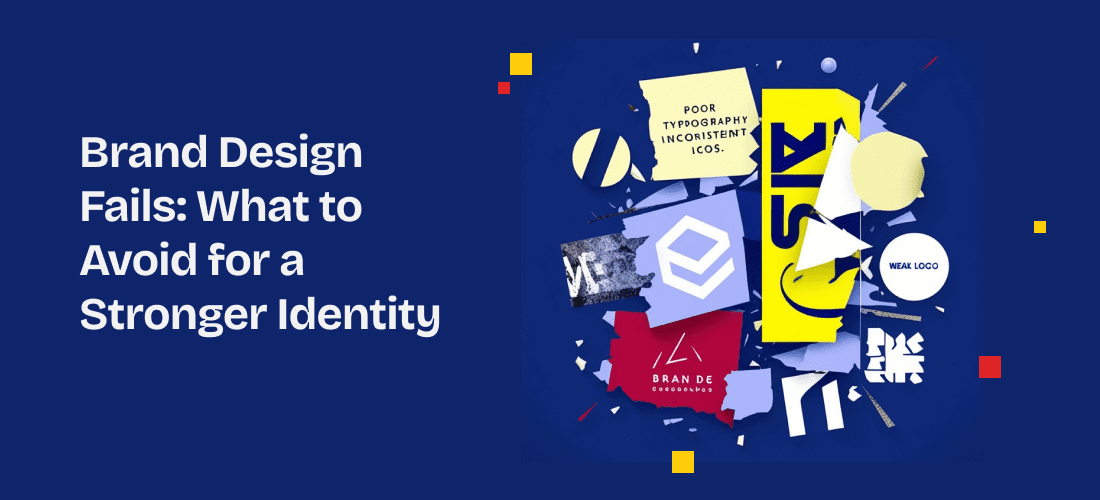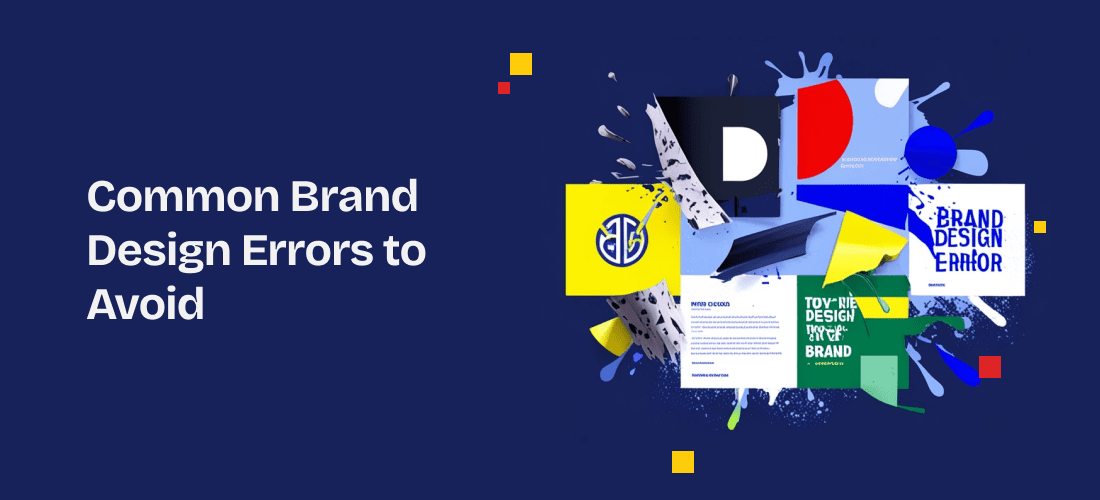
Dec 4, 2024

Brand design has come a long way from being considered merely an artistic endeavor to becoming a fundamental necessity for successful branding. Effective brand design services are crucial for building recognition, trust, and loyalty among consumers. As brands increasingly realize the importance of strong visual identity, the demand for skilled designers is on the rise, offering a lucrative future for those in the field.
However, with this opportunity comes the responsibility to follow certain design principles. Understanding and avoiding common mistakes is key to growing as a designer and ensuring that your work resonates with audiences. This blog will explore some of the most common design mistakes, providing valuable insights for both designers and companies to refine their branding strategies and achieve greater success.
Brand design services encompass the creation and implementation of visual elements that define a brand’s identity, including logos, color schemes, typography, and overall visual style. These services play a pivotal role in shaping how a brand is perceived by its audience. In an era where attention spans are shorter than ever, innovative and eye-catching design is crucial to capture and retain consumer interest. Clever, well-executed brand design not only engages audiences but also reinforces a brand’s message and values, making it memorable among your audience.
On the flip side, poor brand design can severely damage a business’s identity, leading to lost opportunities and diminished brand recognition. An outdated or unattractive design can cause potential customers to lose trust and move on to competitors. This makes it imperative for designers to stay current with trends and continuously refine their skills. A well-designed brand is a powerful asset, while bad design can effectively tank a brand’s reputation and success.

Even the most experienced designers can fall into the trap of making certain mistakes that can undermine a brand’s identity and impact. These common design errors can lead to confusion, reduced brand recognition, and even a loss of customer trust. By being aware of these pitfalls, brand design services can create effective and cohesive brand identities that resonate with their audience. Let’s explore some of the most frequent mistakes made in brand design and how to avoid them.
Consistency is a cardinal rule followed by every brand design company. Without it, a brand’s identity can appear fragmented and unprofessional. This includes consistent use of logos, color palettes, typography, and messaging across all platforms and materials. When these elements vary from one place to another, it can confuse your audience and weaken brand recognition. A lack of consistency can make it difficult for consumers to form a clear and lasting impression of your brand. To avoid this, establish and adhere to clear brand guidelines that ensure uniformity across all touchpoints, from social media to packaging.
Your audience should be at the center of every design decision you make. Ignoring your audience’s preferences, needs, and expectations can result in a product branding design that fails to connect. For example, a playful and colorful design might not resonate with a more conservative, professional audience. To avoid this mistake, conduct thorough research to understand your target demographic, including their behaviors, preferences, and values. Tailoring your design to your audience ensures that your brand communicates effectively and builds a strong connection with those who matter most.
Simplicity is often the hallmark of effective design. Overcomplicating your design with too many elements, fonts, or colors can create visual clutter and distract from your brand’s core message. A complex design can also make your brand harder to recognize and remember – all in all, clutter can overstimulate your audience and confuse them. Instead, focus on clean, straightforward designs that clearly communicate your brand’s identity and values. By simplifying your design, you make it easier for your audience to understand and engage with your brand, enhancing both recognition and recall.
Brand guidelines are essential for maintaining a cohesive and recognizable brand identity. Neglecting to establish or follow these guidelines can lead to inconsistencies that weaken your brand’s impact. Without clear guidelines, different teams and designers of brand design services might use varying elements, resulting in a disjointed brand image. Effective brand guidelines should cover all aspects of your brand’s visual and verbal identity, including logo usage, color schemes, typography, and tone of voice. Ensuring that everyone involved in your brand’s communication adheres to these guidelines is crucial for building a strong and unified brand presence.
Typography plays a significant role in how your brand is perceived. Poor typography choices, such as using too many fonts, selecting illegible typefaces, or failing to align text with your brand’s tone, can detract from your brand’s professionalism and readability. Typography should enhance, not hinder, the clarity of your brand’s message. To avoid this mistake, a brand design company will choose fonts that are both visually appealing and easy to read and limit the number of typefaces they use across the brand. Consistent typography reinforces a brand’s identity and ensures that the content is accessible and engaging.
Color is a powerful tool for product branding design, capable of influencing emotions and behaviors. We often recognize a brand because of its colors. Ignoring the psychological impact of color can lead to a brand design that doesn’t align with your intended message or audience’s perceptions. For instance, using bright, aggressive colors for a wellness brand might convey the wrong impression. Understanding color psychology helps you select a palette that resonates with your audience and reflects your brand’s values. Thoughtful color choices can evoke the desired emotions and associations, strengthening the connection between your brand and your audience.
Brand design is not static; it needs to evolve to stay relevant in a changing market. Failing to update your brand design over time can make your brand appear outdated and out of touch with current trends and consumer expectations. However, evolution doesn’t mean completely overhauling your brand—it’s about making thoughtful updates that keep your brand fresh while preserving its core identity. Approach a brand design company to regularly review and refresh your brand design to ensure that it continues to resonate with your audience and remains memorable among its audience.

Avoiding common brand design mistakes requires both awareness and continuous improvement of your skills as a designer in a brand design agency or as a freelancer. The first step is to thoroughly understand your brand’s identity and target audience. Conducting research and gathering insights about your audience’s preferences and behaviors will ensure that your design choices resonate with them. Consistency is another crucial aspect—establishing and adhering to clear brand guidelines helps maintain a unified and professional brand image across all platforms.
To avoid overcomplicating your designs, embrace simplicity. Focus on clean, clear visuals that effectively communicate your brand’s message without unnecessary clutter. Pay close attention to typography and color psychology, as these elements significantly impact how your brand is perceived. Choose fonts that are legible and align with your brand’s tone, and select colors that evoke the desired emotions and associations.
Finally, staying current with design trends and industry best practices is essential. When you are part of a brand design agency, you will have access to regularly update your skills and knowledge which will help you keep your brand design fresh and relevant. By actively seeking feedback, experimenting with new ideas, and refining your approach, you can avoid common pitfalls and create designs that are both innovative and effective.
Also Read – A Style Guide Toolkit to Make Your Brand Unforgettable
Brand design is a powerful tool that allows you to craft captivating stories and visually communicate the essence of a brand. To truly harness this power, it’s important to continuously improve your design skills and stay updated with the latest trends and best practices. This blog serves as a starting point for recognizing and avoiding common mistakes in brand design services, but the journey doesn’t end here. As a designer, you should build your own knowledge base, explore different styles, and adapt to the unique aesthetic of each brand you work with. By doing so, you’ll navigate the complexities of branding more effectively and create designs that not only captivate but also resonate deeply with your audience. Never stop learning, experimenting, and pushing the boundaries of your creativity—it’s the key to elevating your work and making a lasting impact.